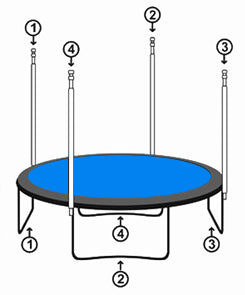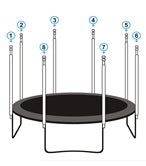No Products in the Cart
Purchasing Replacement Parts
Even with proper maintenance and use, trampoline parts can suffer from wear and weather exposure over time. It’s important to replace damaged or worn parts before jumping on the trampoline, to ensure that jumpers are safe.
To order a replacement part, you will need to take measurements and make sure that the part you order is compatible with your trampoline. Look for the part you need in this section of trampoline accessories for sale to find out how to measure for it and ensure compatibility.
Choosing universal or branded replacement parts
Upper Bounce offers universal trampoline replacement parts that can be used with any brand of trampoline, in addition to replacement parts made specifically for Upper Bounce trampolines.
How to measure your trampoline
All replacement parts are sized with reference to the trampoline size.
For a round trampoline, the size is the diameter of its frame. To determine the diameter of a round trampoline frame, measure it from outer edge to outer edge, crossing the center of the trampoline. To ensure that your measurement is as accurate as possible, take two perpendicular measurements. If they are not identical due to bending of the frame, use an average of the two measurements.
For a rectangular or oval trampoline, take two measurements: Measure the length from outer edge to outer edge of the frame, then measure the width from outer edge to outer edge of the frame. When measuring an oval trampoline, make sure you are taking the measurements at the longest and widest points, respectively.

Take two measurements from edge to edge of a round trampoline, then average them to get the size.

Measure the length and width of rectangular and oval trampolines separately.
How to select and measure for replacement parts
Jumping Mats
- Determine the shape that you need (round, rectangular, oval or square).
- Measure the trampoline (How to measure)
- Determine whether your trampoline uses bands or springs.

Jumping mat that attaches to the
frame with springs

Jumping mat that attaches to the
frame with bands.
- Count the springs or bands on your trampoline.

You can count the springs or bands on your trampoline by counting each attachment point or V-ring.
Measure the spring size

To determine the size of a spring, measure it, without stretching it, from hook end to hook end.
How to determine the Jumping Mats measurement?
- Measure your trampoline and convert the measurement to inches.
- Measure a spring from your trampoline.
- Subtract 2x the spring measurement from the trampoline measurement.
- Subtract 5 inches.
- The result is the mat size, straight across from V-ring to V-ring.
Example:
Trampoline size: 14 feet = 168 inches
2x spring size: 2x 7.5 inches = 15 inches
Jumping mat size: 168 - 15 - 5 = 148 inches (12.3 feet)
Note that for rectangular, square and oval trampolines, measurements must be made separately for length and width. In this case, use the same formula each time, substituting trampoline length and trampoline width for trampoline size.
Mini-Trampoline Mats
- Measure the trampoline (How to measure)
- Determine whether your trampoline mat attaches with V-rings or tabs. (For trampolines that use tabs, purchase S-hooks separately.)

A jumping mat that attaches with V-rings

A jumping mat that attaches with tabs.
- Count the V-rings or tabs on your trampoline.
Safety Pad

- Determine the shape that you need (round, rectangular, oval or square).
- Measure the trampoline to select a pad that will fit.(How to measure)
- Choose between Super and Premium pads. Premium pads are thicker.
- Choose a color.
Springs

- Measure the spring size from hook to hook. (How to measure)
Enclosure Sets

- Check whether you need an outside enclosure set (attaches to the outside of the trampoline) or an inside enclosure set.

An outside enclosure set with the net attached to the outer edge of the frame.

An outside enclosure set with the net attached to the inner side of the springs.

An inside enclosure set with the net attached to the trampoline mat.
- Count the legs on your trampoline. You can use one or two enclosure poles for each W-shaped leg support.

One pole per leg

Two Poles per leg
- Measure the diameter of the trampoline legs. Make sure the connectors in the replacement set you buy are the right size to fit onto the trampoline legs.

Measure leg diameter from edge to edge at the widest point.
Enclosure Nets

- Determine the shape of your trampoline (round, rectangular, oval, square, octagonal).
- Measure your trampoline (How to measure)
- Count the enclosure poles. If your enclosure poles are arches, count each arch as a single pole. Enclosure poles should be placed at equal distances from each other around the trampoline.

Curved enclosure poles

Straight enclosure poles

Arched enclosure poles.
There are two types of universal nets. One type comes in two sizes, for smaller and larger trampolines. This type of universal net has thicker mesh and bigger holes. The second type is available for every size trampoline and has straps that attach to enclosure poles. This type of universal net has standard mesh.
- Determine whether your enclosure poles arch at the top. If so, you need a net with sleeves on top for the arches, or a net that will attach with straps to arches

Enclosure net that attaches with sleeves

Enclosure net that attaches with straps.
If your enclosure net will attach with a ring on top, you will need a net with a sleeve on top.

Curved poles have pole caps with hooks for
attaching the enclosure ring.
If you have straight poles you can choose between a net that will attach with straps to the poles, or a net with pole sleeves that will slide over the poles of your trampoline.

An outside enclosure set with the net attached to the outer edge of the frame.

An outside enclosure set with the net attached to the inner side of the springs.

An inside enclosure set with the net attached to the trampoline mat.
Pole Sets

- Count the legs on your trampoline
(How to measure) - Measure the diameter of the trampoline legs.

Measure pole from inside
- Determine whether the poles are straight or curved.
Pole Caps

- Count the enclosure poles.
- Measure the diameter of the hole in an enclosure pole.

- Determine whether the poles are straight or curved.
- Determine whether you need caps to cover the poles for an outside net, or caps for an inside net that attaches to a hole in the pole cap with a strap.
Foam Sleeves

- Count the enclosure poles.
- Measure the diameter of the enclosure poles (without foam sleeves). (How to measure)
- Measure the assembled height of an enclosure pole.
PVC Sleeves

- Count the enclosure poles.
- Measure the assembled height of an enclosure pole.
Hardware (Clamps, Bolts and Connectors)
- Count the enclosure poles or trampoline legs, depending on the location of the hardware you need to replace.
- Measure the diameter of the enclosure poles or trampoline legs, depending on the location of the hardware you need to replace.

A smaller U-bolt connector

A larger connector




